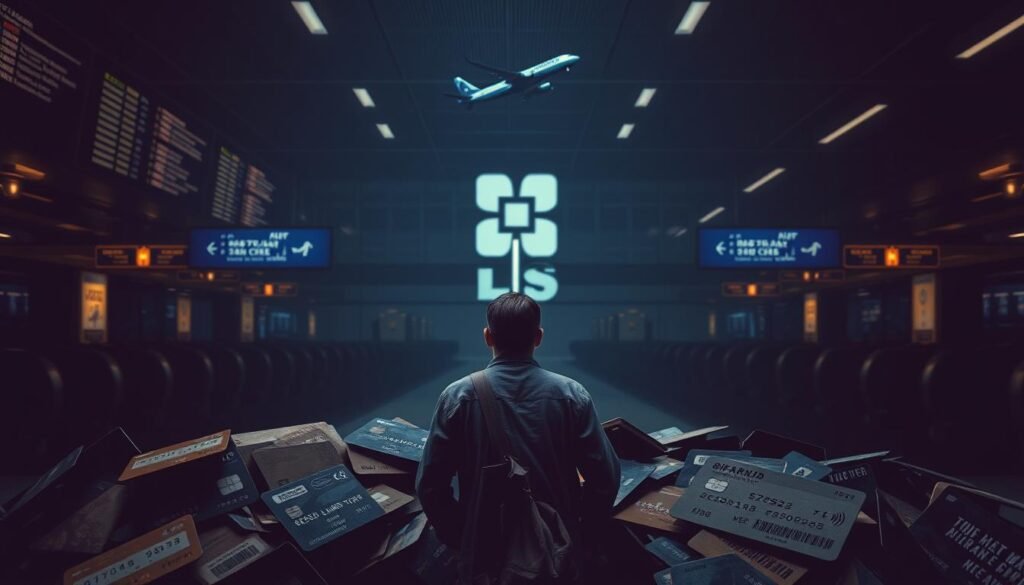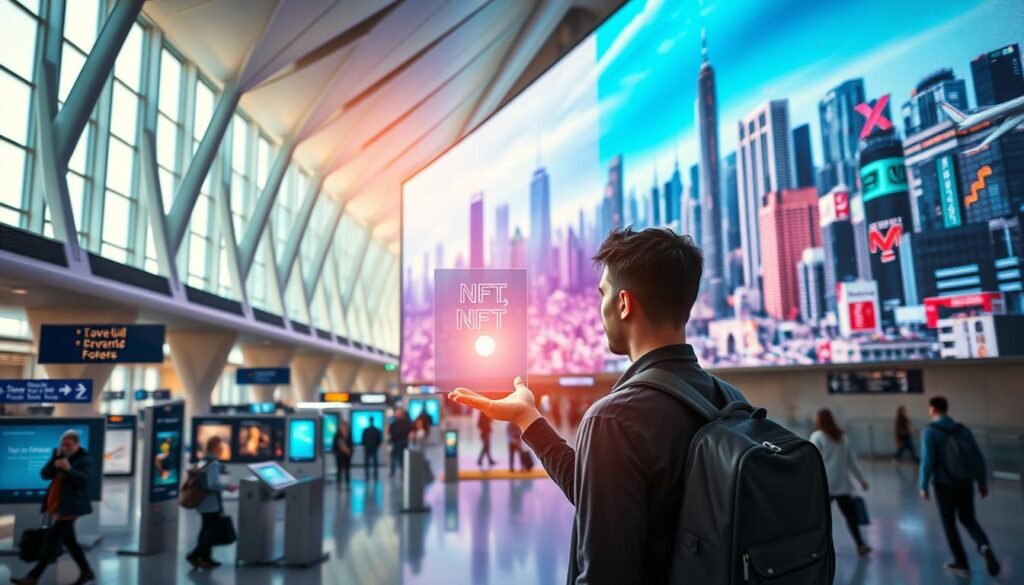Affiliate Disclosure: Travel with Plastic may earn a commission or referral bonus from some links on this site. These affiliate links help support our work and may influence the placement or promotion of certain products or services. However, our content is independently crafted to reflect honest opinions. Not all offers or products are included. There is no additional cost to users when they utilize our affiliate links.
By the end of 2022, over 420 million people worldwide were using cryptocurrency. This shows the growing potential for digital assets in various industries, including travel. NFTs and digital assets are revolutionizing how we earn, redeem, and experience loyalty programs.
The travel industry generates over $9 trillion annually. It’s now embracing a digital transformation. Blockchain technology, cryptocurrency rewards, and digital asset integration are reshaping loyalty programs. These innovations offer travelers more flexibility, value, and personalization.
Major travel companies are already embracing this shift. Marriott International explored letting Bonvoy members redeem points for Ethereum. This shows how digital assets can integrate into traditional loyalty systems.
Travala.com has created its own cryptocurrency, the AVA token. Customers can use it for booking accommodations and earning rewards.
NFTs and digital assets in travel rewards create unique, immersive experiences. Caesars Palace used NFTs to offer exclusive access to VIP areas and events. This approach blends digital assets with real-world perks.
This trend appeals especially to younger generations. In fact, 71% of millennial millionaires own cryptocurrency.
Key Takeaways
- Cryptocurrency usage is widespread, with over 420 million users globally
- Major travel brands are exploring blockchain and digital asset integration
- NFTs offer unique ways to enhance loyalty programs and travel experiences
- Younger generations show strong interest in cryptocurrency-based rewards
- Digital assets provide opportunities for personalization and exclusivity in travel
The Evolution of Traditional Travel Rewards Programs
Travel loyalty programs face big challenges today. Americans join many programs but use few. This shows that travel rewards need a makeover.
Current Limitations of Loyalty Programs
Traditional travel rewards often miss the mark. In the US, over $100 billion in points remain unused. This proves these programs lack flexibility.
Consumers crave personalized rewards. Most prefer perks from their recent shopping trips. Current systems struggle to meet these desires.

The Need for Digital Transformation
The travel industry needs a digital upgrade. Blockchain and NFTs offer solutions to old problems. These tools turn points into real assets.
New platforms could unite scattered loyalty systems. This would create a smoother experience for travelers. Users could truly own their rewards.
Consumer Engagement Challenges
Younger travelers present unique hurdles. Many value digital goods more than physical ones. This trend opens doors for NFTs and virtual travel experiences.
Starbucks Odyssey shows new tech isn’t always easy to use. The key is making blockchain systems simple. User-friendly interfaces are crucial.
| Traditional Programs | New Digital Approaches |
|---|---|
| Low engagement rates | Increased user participation |
| Inflexible rewards | Personalized, tradable experiences |
| Fragmented ecosystems | Unified, interoperable platforms |
Understanding NFTs and Digital Assets in Travel
Digital assets are reshaping travel loyalty programs and customer experiences. NFT travel rewards are gaining popularity, with 11.5% of agencies accepting them. This shift marks a big change in the crypto travel world.
Travala has seen a 46% increase in crypto booking volumes. This shows the growing popularity of digital assets in travel loyalty. Web3 loyalty strategies offer instant payments, improving transaction speed and security.

NFTs are being explored as digital passports or tickets. They could streamline check-in processes and offer unique travel experiences. The “Tao” NFT travel card, launching in 2025, will offer discounts, rewards, and VIP perks.
This digital collectible uses blockchain technology. It shows the innovative potential of NFTs in travel. Hotels are also using NFTs in their loyalty programs.
These digital assets can represent exclusive memberships. They offer perks like priority access and room upgrades. By tokenizing loyalty points, guests earn digital assets with real value.
The travel industry is recovering quickly. International tourist arrivals may reach 96% of pre-pandemic levels by mid-2024. Digital assets in travel loyalty programs will redefine the travel experience.
Blockchain Technology Revolutionizing Travel Rewards
Blockchain is reshaping travel industry loyalty programs. It offers innovative solutions to longstanding challenges. This technology creates more efficient, transparent, and user-friendly travel rewards systems.
Smart Contracts for Automated Rewards
Smart contracts are transforming blockchain travel programs. These self-executing contracts automate reward distribution efficiently and transparently. Lufthansa’s Uptrip program lets travelers earn and redeem digital assets for travel perks.
Decentralized Loyalty Systems
Decentralized systems are changing how travelers earn and use rewards. Tokenized rewards allow users to use points across different travel services. This aligns with Deloitte’s finding that 70% of millennials prefer flexible loyalty programs.
Enhanced Security and Transparency
Blockchain creates transparent, unchangeable records for loyalty rewards and transactions. This improved security builds trust between travelers and service providers. Companies like Sleap.io offer exclusive discounts to NFT holders, ensuring transaction transparency.
| Feature | Benefit | Example |
|---|---|---|
| Smart Contracts | Automated reward distribution | Lufthansa’s Uptrip program |
| Tokenized Rewards | Cross-service flexibility | 15% of American travelers prefer crypto payments |
| Blockchain Records | Enhanced transparency and trust | Sleap.io’s token-gated discounts |
Blockchain technology in travel rewards continues to evolve. We can expect more innovative applications like NFTs in airline miles. Digital collectibles as travel perks will create engaging and valuable experiences for travelers.
The Future of Travel Rewards: Integrating NFTs and Digital Assets
Travel rewards are changing fast. They now include blockchain loyalty programs and NFTs. This new approach is changing how we earn and use travel perks.
Tokenized Travel Benefits
Tokenized travel experiences are changing loyalty programs. Travala has added the Solana blockchain to its platform. Users can now book travel using SOL, USDT, and USDC without fees.
Travala’s AVA token on Solana powers a unique loyalty program. It offers SOL travel rewards to users.
Cross-Platform Compatibility
Blockchain loyalty programs connect different travel services. A new project aims to tokenize the top 10,000 flight routes worldwide. Users can earn tokens when flights use their owned routes.
This system works with airlines, hotels, and travel experiences. It creates a smooth reward ecosystem for travelers.
Personalized Travel Experiences
Crypto rewards are creating unique travel adventures. Jeju Island’s “Tao” NFT travel card shows this trend. It will launch in late 2025.
The card offers travel savings, digital currency rewards, and VIP access. It also includes a digital travel diary. This mix of perks appeals to Millennials and Gen Z travelers.
As these technologies grow, we’ll see more exciting tokenized travel experiences. They will blend digital assets with real-world adventures in new ways.
Web3 Integration in Travel Loyalty Programs
Travel loyalty programs are changing with Web3 tech. This brings new digital currency benefits for travelers. Blockchain platforms now offer creative NFT-based travel rewards.
Forbes Web3 and qiibee foundation have teamed up. Their blockchain platform lets users earn various rewards. These range from airline miles to charity donations.
This tech ensures clear and safe point management. It’s setting a new bar for the travel industry.
The loyalty market is growing fast. It may earn over $24 billion in five years. Yuga Labs has already made about $150 million from tokenized loyalty.
This trend is changing how travelers use reward programs. It’s making them more engaging and flexible.
| Web3 Loyalty Feature | Benefit |
|---|---|
| Smart Contracts | Real-time rewards, reduced costs |
| Tokenization | Secondary markets for rewards |
| NFT Integration | Unique rewards, increased engagement |
New programs are popping up with cool features. Some offer NFTs for top flight routes. Travelers can earn tokens for flights on these routes.
They can get bonuses for collecting sets. These systems use secure blockchains like Polygon. They promise better flexibility and community involvement in travel rewards.
Cryptocurrency Adoption in Travel Rewards
Travel rewards are going digital with cryptocurrency and blockchain technology. This change is transforming how travelers manage their rewards. It’s making earning and spending points easier than ever before.
Digital Payment Solutions
Crypto payments are making international travel bookings simpler. Travala reported that 80% of its users paid with crypto in 2024. They partnered with Skyscanner and KAYAK, bringing crypto travel to more people.
Despegar, a Latin American travel agency, saw new trends. Half of their crypto transactions came from first-time users under 35.
Cross-Border Transaction Benefits
Blockchain is changing how we handle international money transfers. Binance Pay now offers easy crypto payments for travel. This removes the need for currency exchange.
More travel companies are using blockchain for payments. It’s growing, with 11.5% of companies on board. The perks include lower fees and quicker processing.
Crypto-Based Reward Systems
Travel companies are offering cryptocurrency rewards in their loyalty programs. Travala’s AVA Smart Program gives up to 13% savings in Bitcoin or AVA rewards.
Singapore Airlines created a blockchain program for converting miles into digital tokens. These new systems give customers more options. They can now trade or sell their rewards.
Digital assets in travel rewards create new opportunities. Both travelers and companies benefit from these changes. We can expect more creative uses of blockchain and cryptocurrency in future travel experiences.
Metaverse and Virtual Travel Experiences
The travel industry is embracing the metaverse, blending digital innovation with traditional loyalty programs. This shift creates exciting opportunities for travelers. Destinations can now be explored in new, immersive ways.
Digital Collectibles and Virtual Properties
Luxury brands are leading the charge in metaverse travel experiences. Louis Vuitton launched NFTs featuring iconic travel trunks. These exclusive virtual assets start at €39,000, showcasing their value in travel loyalty programs.
Immersive Travel Planning
Decentraland and The Sandbox are revolutionizing travel planning. These platforms allow users to explore virtual versions of real-world destinations. This enhances the pre-trip experience for travelers.
NFT-Powered Virtual Events
NFT-based incentives are becoming key in virtual travel events. Platforms like Spatial host immersive exhibitions and collaborations. Travelers can collect unique digital souvenirs from their virtual journeys.
| Platform | Key Features | Travel Application |
|---|---|---|
| Roblox | Immersive experiences, in-game economy | Virtual hotel tours, loyalty point earning |
| Decentraland | Virtual land ownership, digital commerce | Destination previews, virtual travel agencies |
| Upland | Real-world location-based properties | Virtual city exploration, property-based rewards |
Metaverse travel experiences are gaining popularity. NFTs and virtual assets are finding innovative uses in travel loyalty programs. This digital shift promises more engaging and personalized experiences for future travelers.
Implementation Challenges and Solutions
Web3 loyalty strategies in travel programs face unique challenges. The crypto travel ecosystem promises benefits but struggles with adoption and complexity. Let’s explore these issues and their potential solutions.
User onboarding is a major hurdle. Many travelers don’t understand blockchain technology or digital wallet management. Travel companies can simplify this process through partnerships with wallet-as-a-service providers.
Creating step-by-step tutorials can help both crypto-savvy users and newcomers. This approach makes nft travel rewards more accessible to a broader audience.
Security concerns are another significant challenge. Users worry about transaction safety and personal data protection. Implementing robust security measures can build trust in the system.
Encryption protocols and multi-factor authentication are examples of effective security solutions. These measures help reassure users about the safety of their digital assets.
| Challenge | Solution |
|---|---|
| Payment Complexity | Offer multiple payment options (credit cards and cryptocurrencies) |
| User Interface Complexity | Design user-friendly interface with clear instructions and support |
| Regulatory Compliance | Navigate varying regulations and register with financial authorities |
| Market Volatility | Peg loyalty tokens to stable assets or fiat currencies |
Slovenia’s “I Feel NFT” project shows the potential of digital assets in travel loyalty programs. By tackling these challenges, the travel industry can unlock web3 technologies’ full potential.
This approach can create more engaging and valuable experiences for travelers. It opens up new possibilities for reward systems and customer engagement.
Conclusion
Travel rewards are changing with NFTs and digital assets. Blockchain will transform how we earn and use travel perks. Cryptocurrency wallets are evolving beyond tracking points to secure travel payments.
These digital wallets are expected to grow to $3.675 billion by 2033. They’re opening doors for new NFT uses in loyalty programs. This includes exclusive travel experiences that weren’t possible before.
Digital assets in travel rewards offer better security and accessibility. Users can manage their perks across platforms with ease. This builds trust and makes things more convenient.
NFTs have shown success in other industries, like Taco Bell’s campaigns. This hints at their potential in travel. Travel companies can create unique, sought-after rewards using NFTs.
The future of travel rewards looks bright with crypto and digital assets. However, challenges like copyright issues and market volatility remain. As we tackle these hurdles, a new era of travel is emerging.
Blockchain, NFTs, and digital assets are coming together in exciting ways. They’re creating more personal, flexible, and rewarding travel experiences for everyone.

